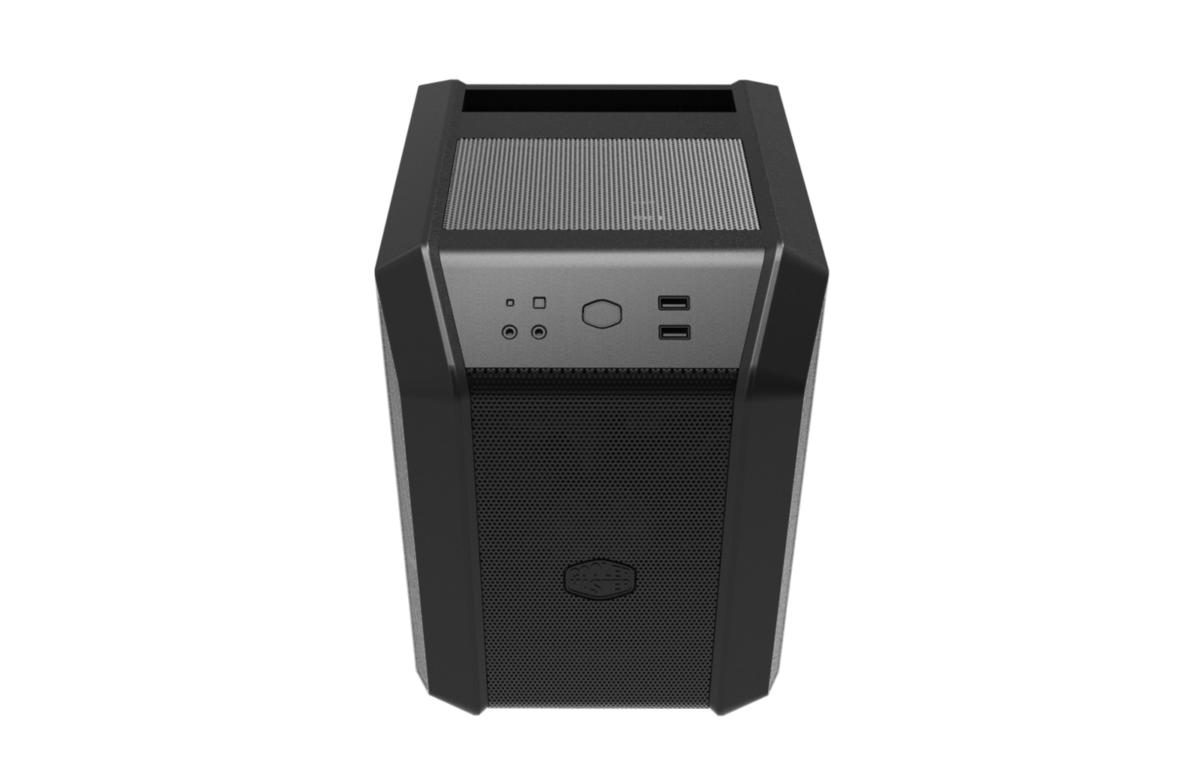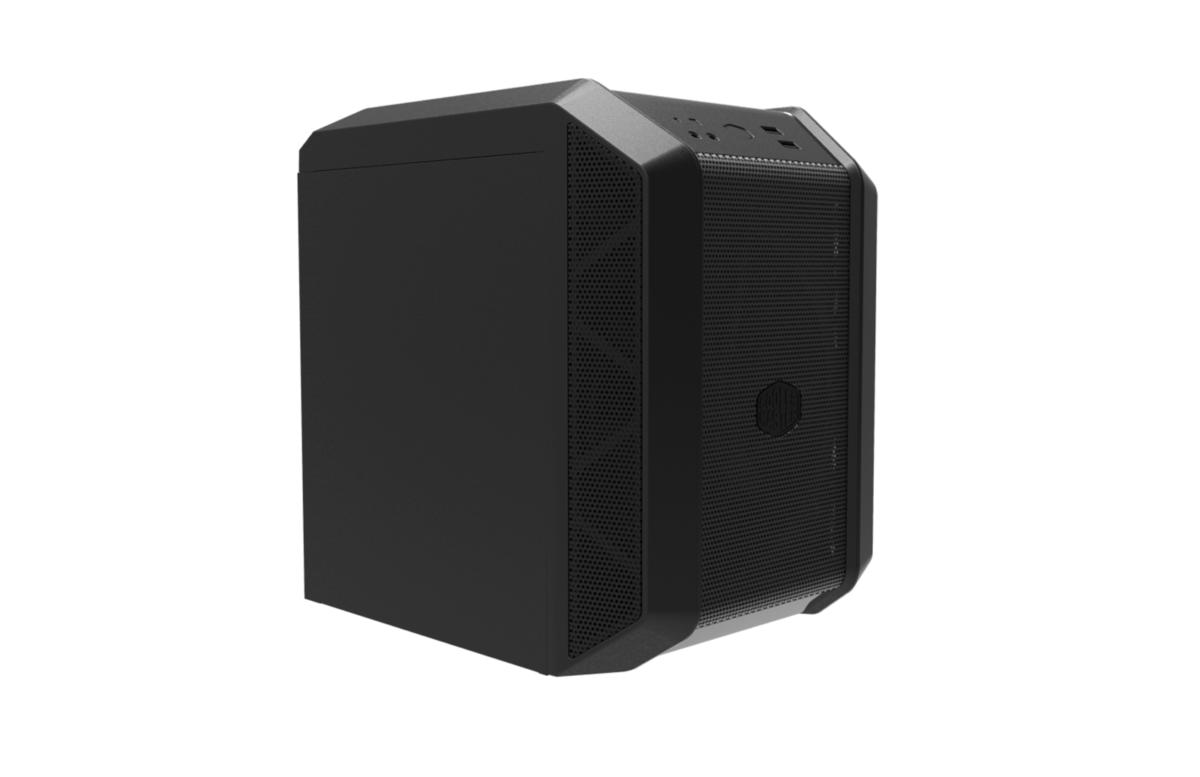Cooler Master MasterCase H100: Specs, overview, and teardown - peltonfetwerivid
At Computex 2019, several miniskirt-ITX computer cases on the patronage show's stun caught our eye. Among them was Cooler Master's MasterCase H100, a pint-sized plus to the companionship's H-series. The compact tower's 200mm RGB first fan—the signature feature of the H-serial publication line—makes it unique among its challenger.
So when a sample of the MasterCase H100 arrived just ahead of its July 9th launch, we were eager to build in IT. Other projects (like the Ryzen 3000 and Radeon RX 5700 and 5700 XT launches) kept us from plunging in rightmost by, however. Instead, we settled for hauling it out of the box for a once-over, and so grabbing a screwdriver and opening it up.
Specs and plan
Available in black and "iron out gray," the MasterCase H100 is taller than information technology is encompassing, though the case does have cube-like proportions: This itty-itty-bitty tower measures 12.28 x 8.5 x 11.85 inches (312 x 216 x 301 mm), with a listed volume of 17.6 liters.
Accordingly, the H100 only accommodates artwork cards with a maximum of 210mm in length (180mm when a front radiator is installed). That limits the options for graphics cards compared to competing cases that sustain little height and more depth, like the Silverstone SG13 or even Cooler Master's own Elite 130.
For CPU coolers, the H100 has enough headroom to accommodate up to 83mm in height.
 Cooler Skipper
Cooler Skipper The Cooler Master MasterCase H100's front I/O instrument panel has two USB 3.0 ports, a microphone jack, an audio jack, and a reset clitoris.
A 200mm, 800 RPM RGB fan on the front provides each of the cooling for the case. The RGB firing can be controlled from the motherboard (if supported) or the example's reset button. If you prefer to install an AIO liquid cooler, you can swap out the 200mm fan for a single 120mm or unwed 140mm radiator instead.
Similar Tank Master's some other H-serial publication cases, the H100 sports mesh on the front and top panels, with dust filters behind all division. Also on the best panel is a reinforced-in carrying hold, found toward the rear of the case, besides as an I/O panel with two 3.5mm audio jacks, two USB 3.0 ports, and a reset button at the battlefront.
At the back is the climbing bracket for a full-sized ATX power render.
Indoors the case
The MasterCase H100 comes apart easily, which makes the jigsaw mystifier–equal process of edifice in a itty-bitty-form factor case much simpler. Even if you don't read the manual, the order of the teardown is clear, and removing the individual panels and plates is straightforward. No ill-chosen angles patc removing screws or fiddly plastic clips found here.
You will have to work your way from one side of the case to the other, however, which may follow unexpected if you're accustomed to removing both lateral panels on a case at the start.
Popping off the archetypal side panel reveals a storage repel climbing plate, which holds up to two drives. (Two more than floater for drive sit at the bottom of the case; overall, you get one combo spot for either a 2.5- OR 3.5-inch drive, and another three consecrate 2.5-edge spots.) Removing the plate opens skyward access to the full interior of the case.
 Cooler Master
Cooler Master The Ice chest Master MasterCase H100 can accommodate graphics card game busy 210mm in length (180mm if a radiator is installed at the anterior of the case).
For better maneuverability while building, we advise continuing to teardown the case to pull off the top control panel, the metal plate that sits over the power provision mounting bracket, and the power supply climb angle bracket. To DO so, you'll in reality need to likewise remove the front panel to access part of the screws securing the transcend panel. Fortunately, when compared to other cases, the H100's front panel doesn't take excessive effort to pry it loose.
Once the top panel is past, it's a spearhead-shaped matter of unfastening another set of screws and sliding out the short bronze plate that remains, then doing the same for the power supply mounting square bracket. At this show, you backside pick out to pull off the second side panel, which involves more screws and releasing its plastic clips.
Pricing and initial thoughts
Cooler Master's MasterCase H100 is a tidy and attractive case, though with an MSRP of $69.99, IT Crataegus oxycantha move over utilitarian builders pause. The previously mentioned Silverstone SG13 and Cooler Master Elite 130 are both cheaper away most $10, and more importantly, they can support bigger, beefier graphics cards.
Interested builders won't care about the money, but they will likely wonderment about the H100's internal temperature formerly a overfull set of parts are installed. IT's a valid concern, As just one revile exists for cable tie down-offs. If the front fan can move enough air through the character, IT's not a problem, but the question can only be settled through real-world experience.
Without having built in the case, I evidently can't remark on this point, just that makes me solitary deficiency to get to it character of the experience sooner rather than later.
Fudge factor, 7/9/19: Clarified the positions of the drive bays within the case.
Source: https://www.pcworld.com/article/397724/cooler-master-mastercase-h100-specs-and-teardown.html
Posted by: peltonfetwerivid.blogspot.com


0 Response to "Cooler Master MasterCase H100: Specs, overview, and teardown - peltonfetwerivid"
Post a Comment